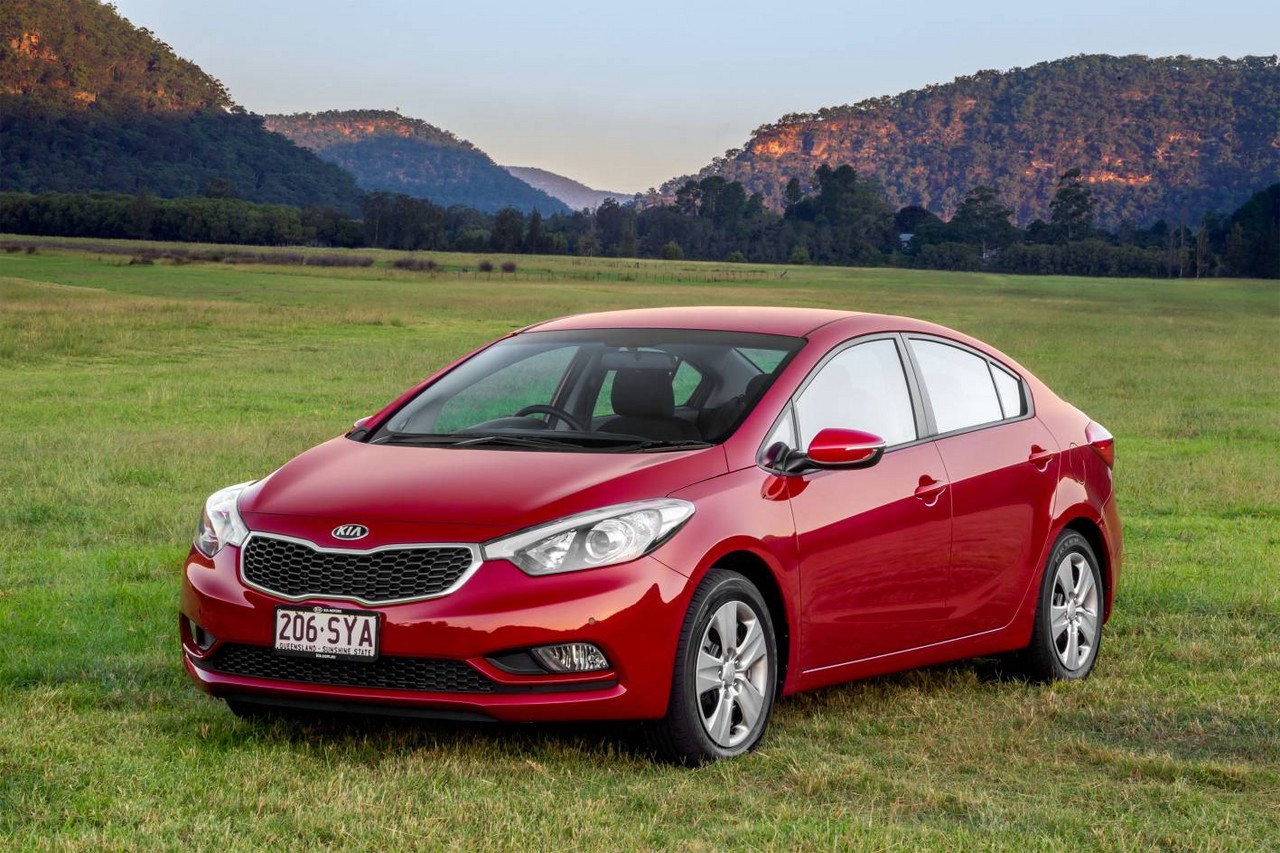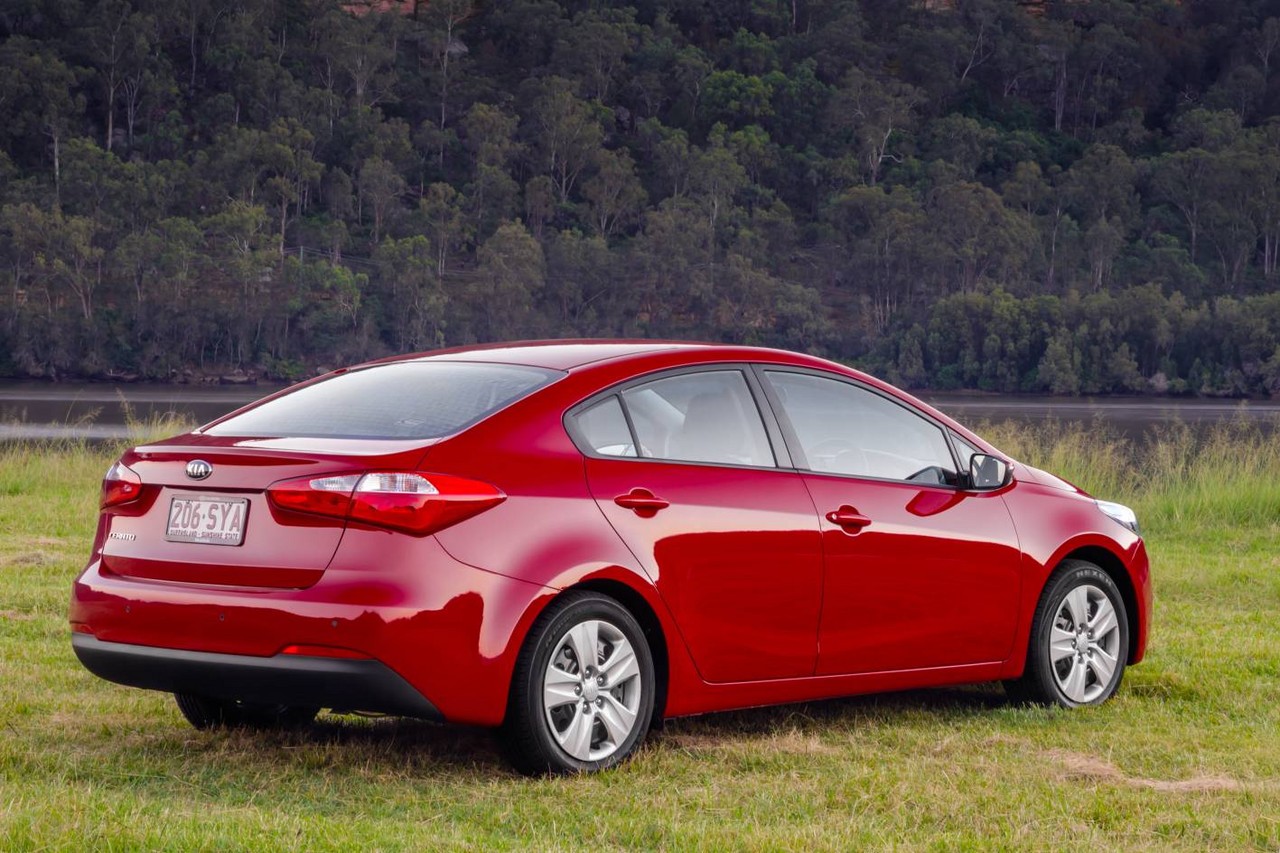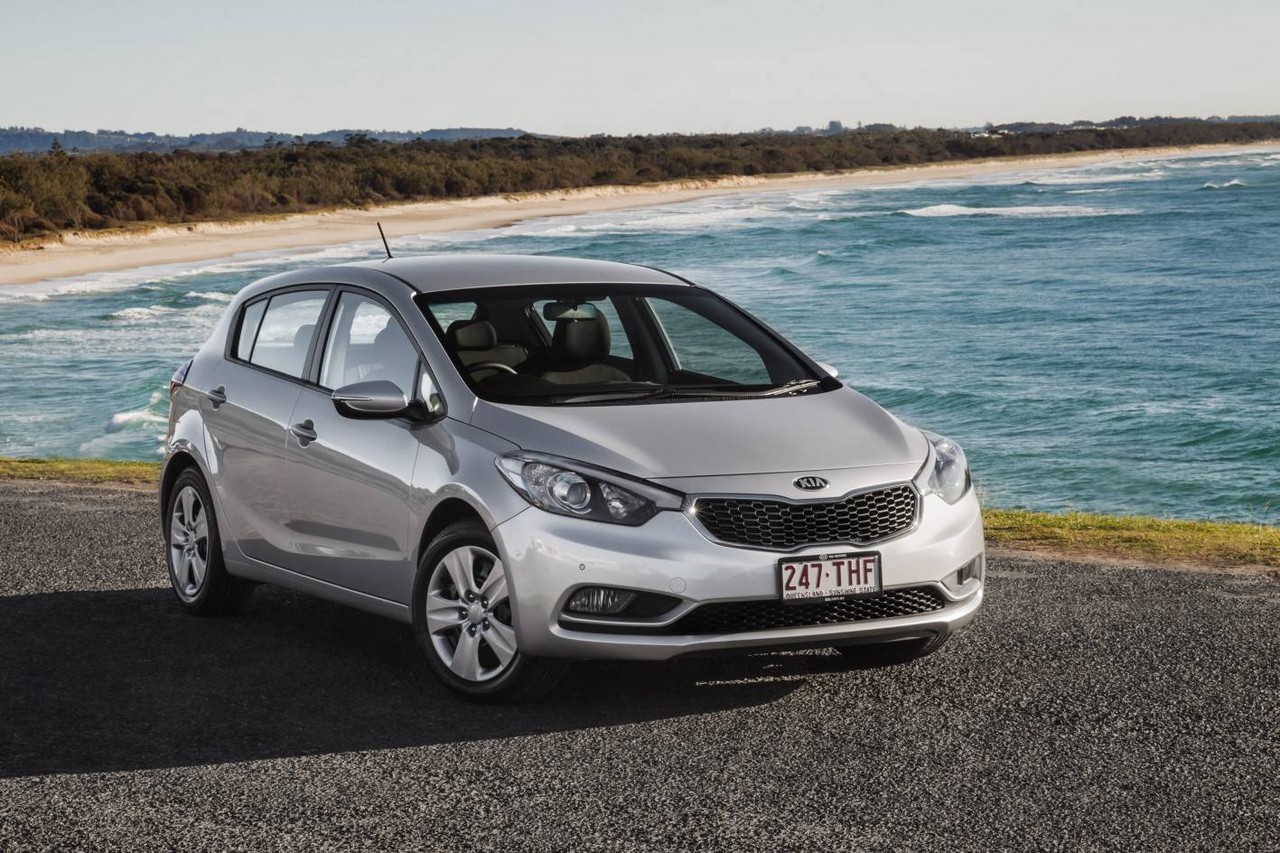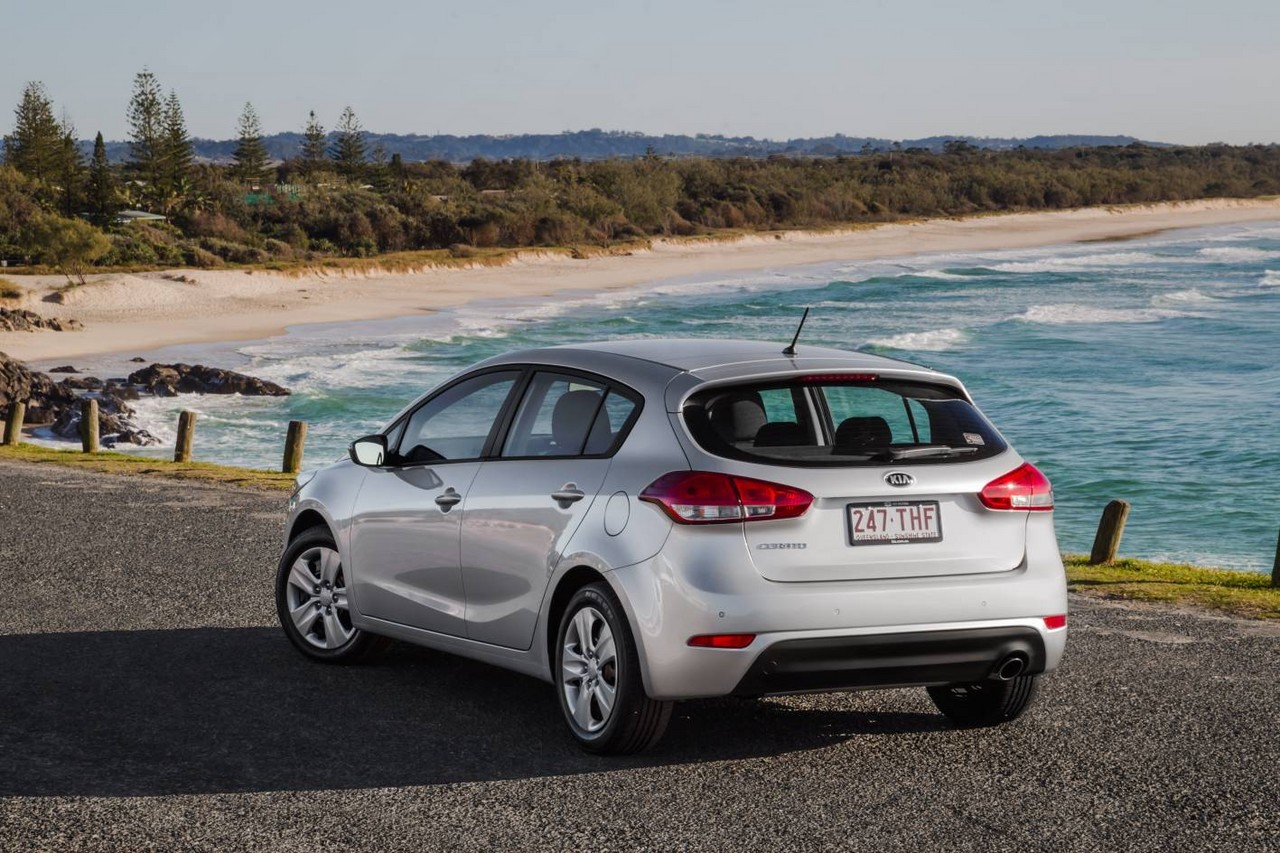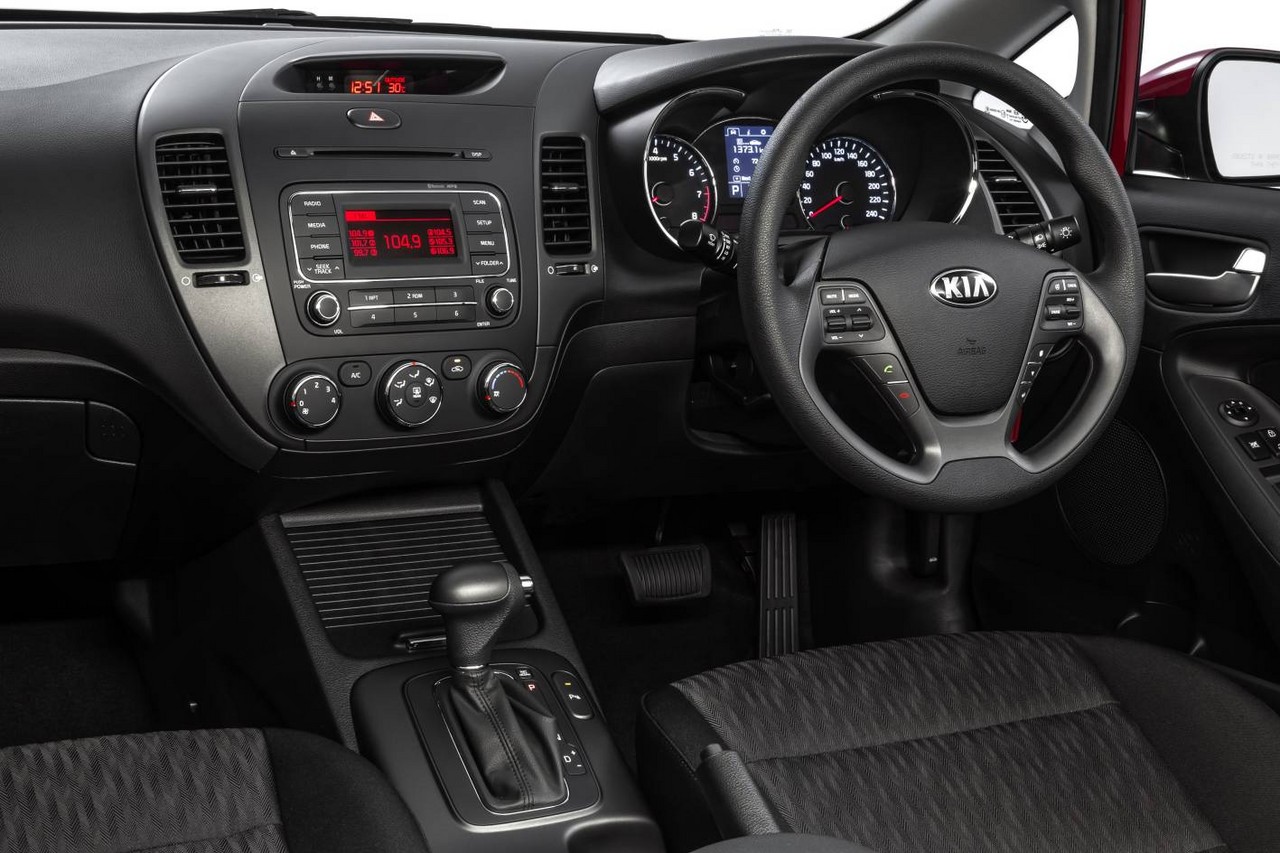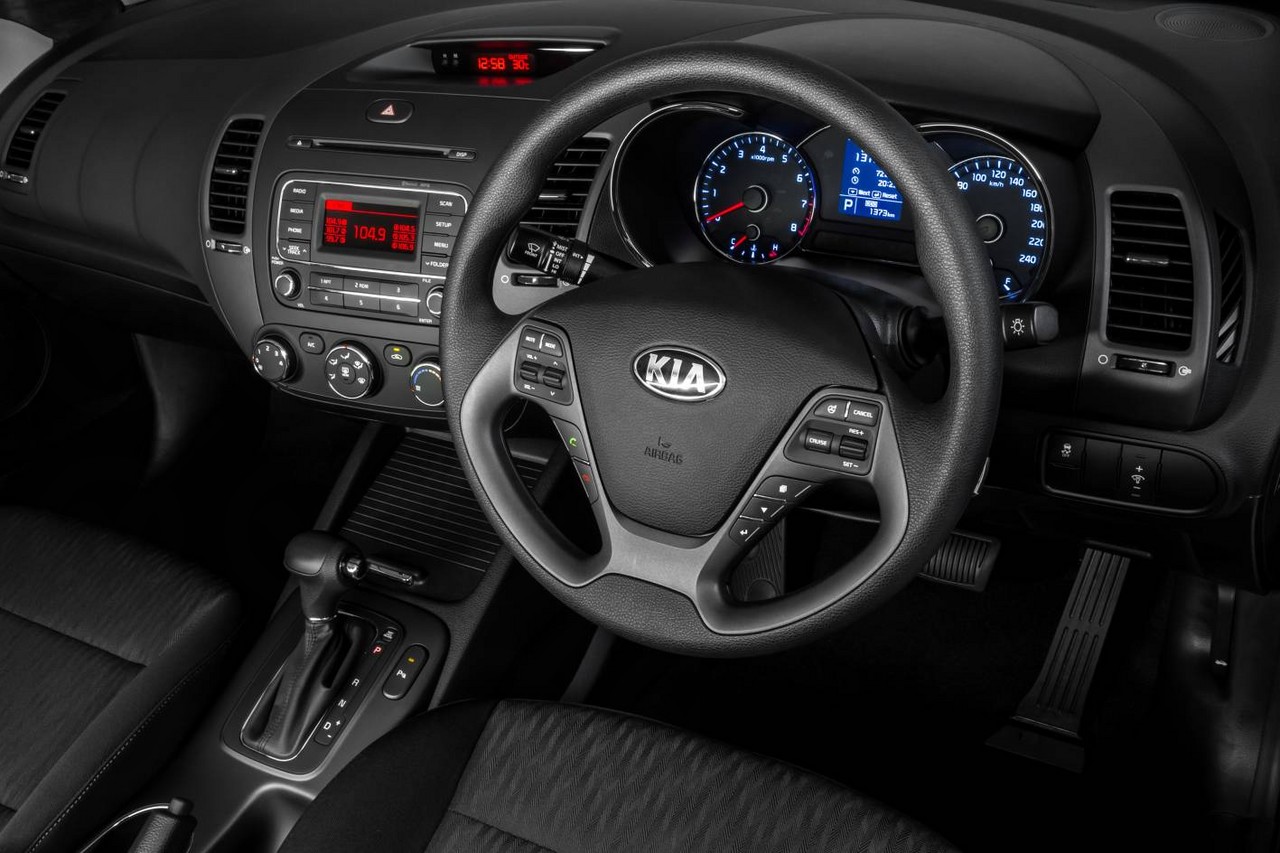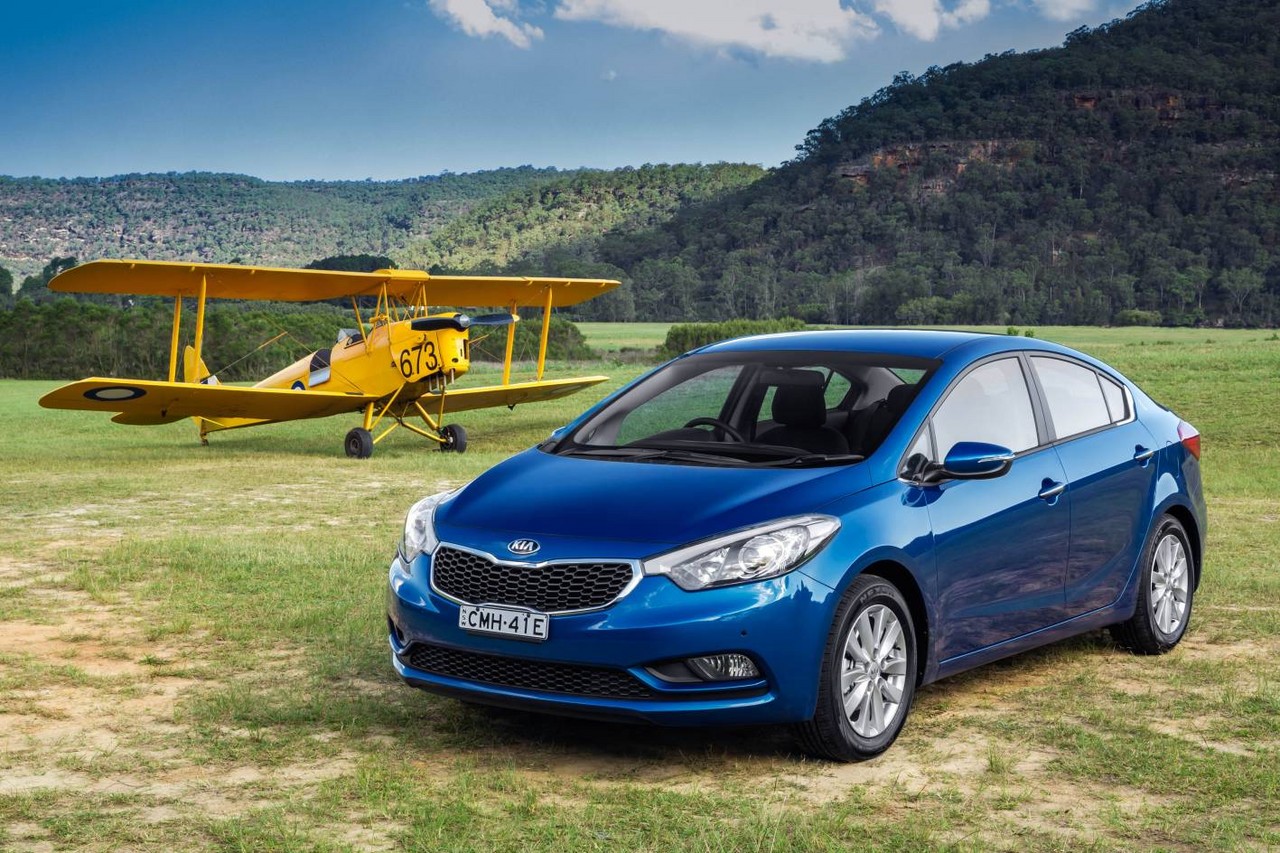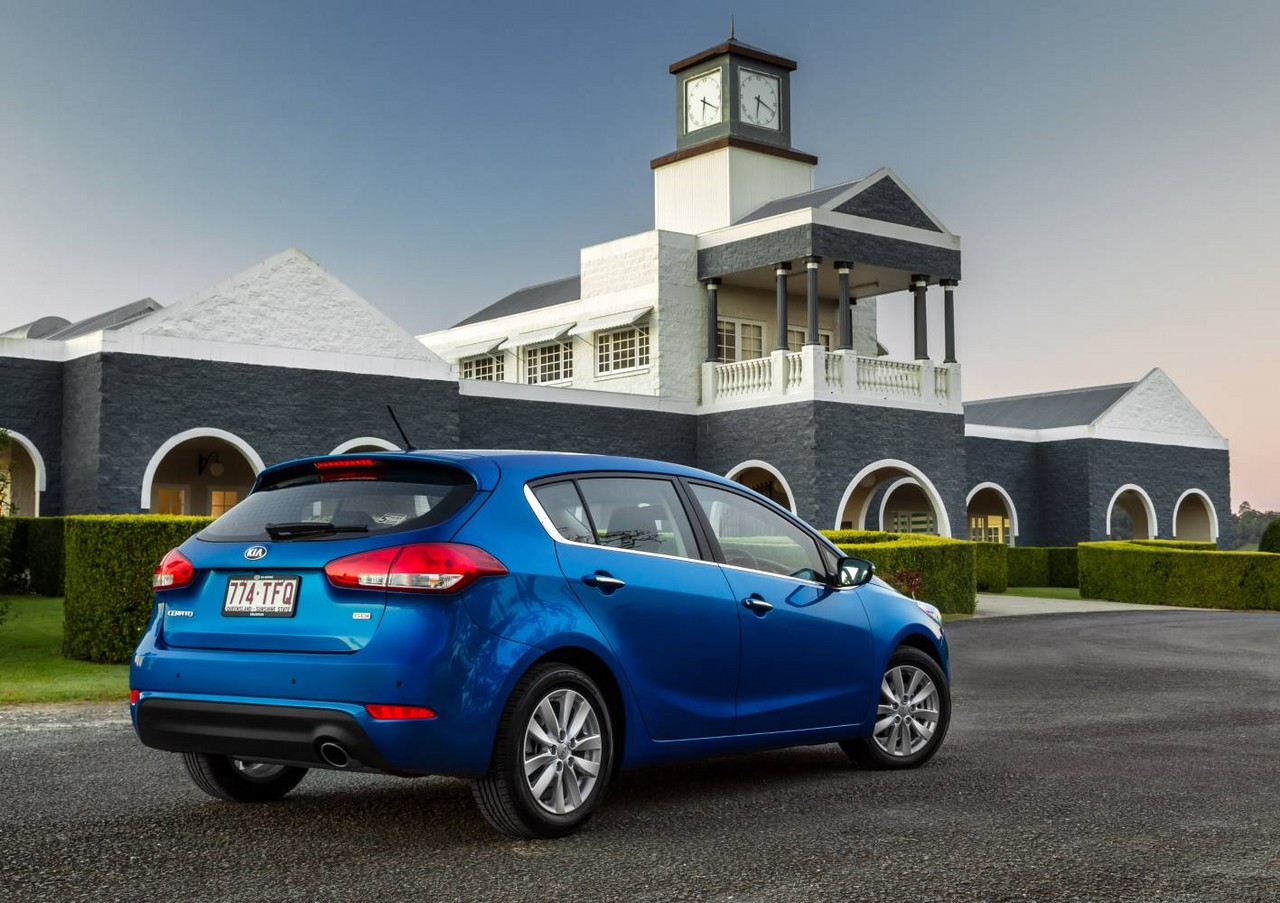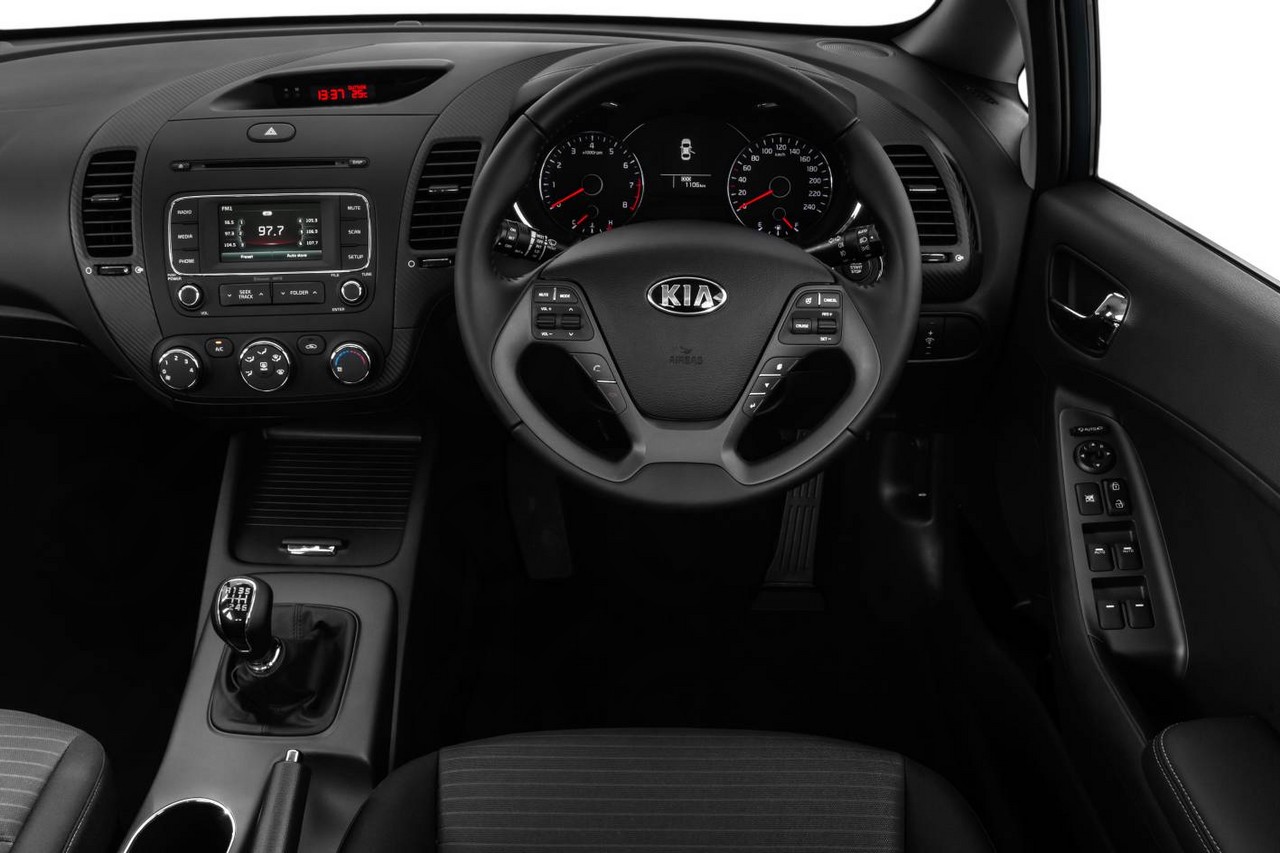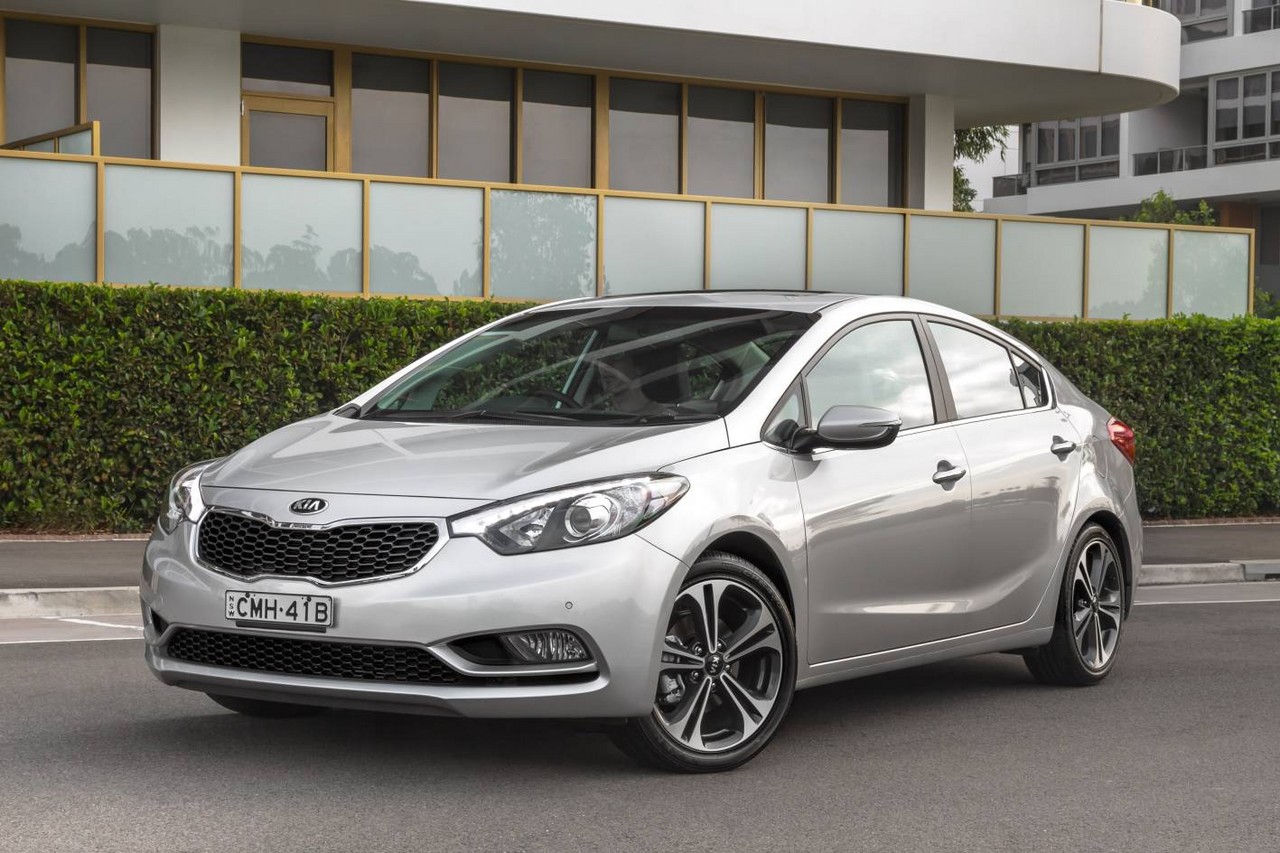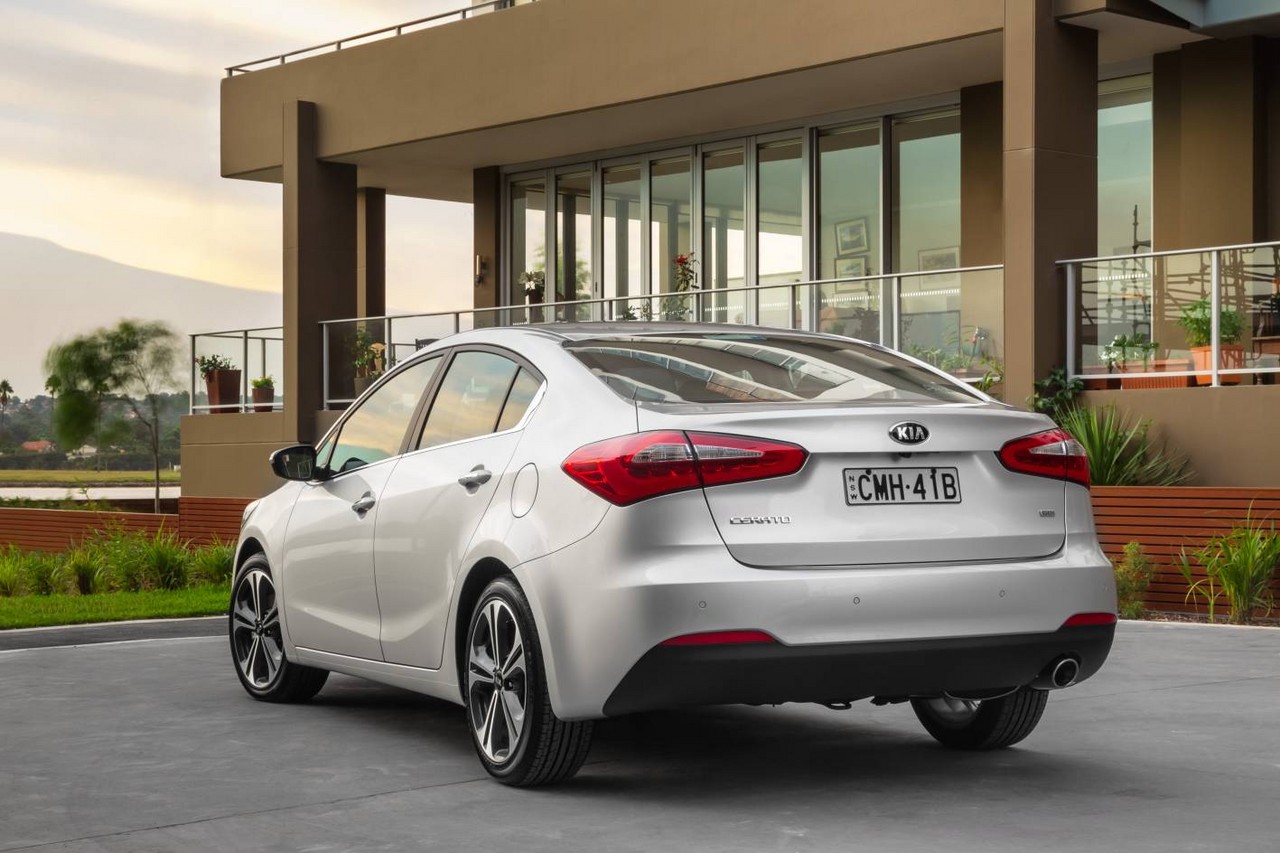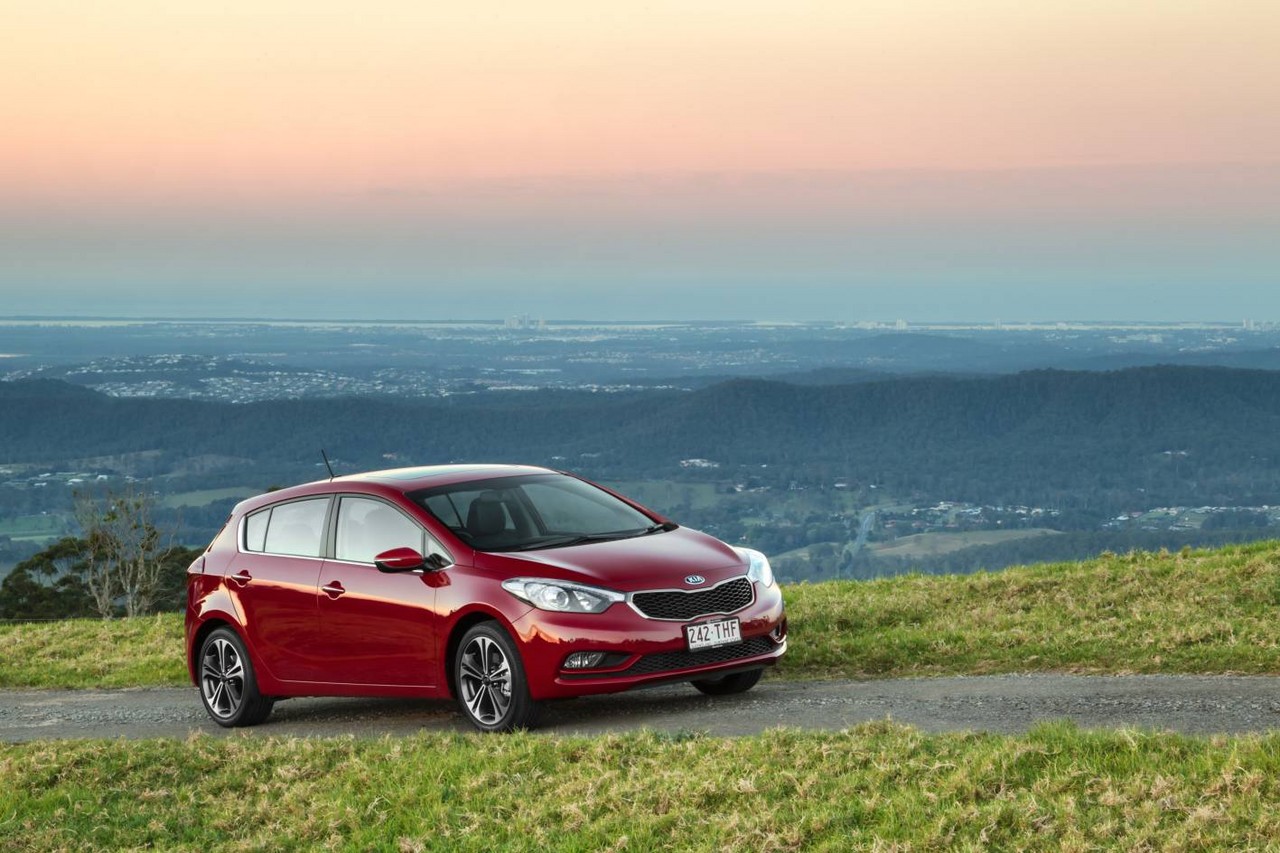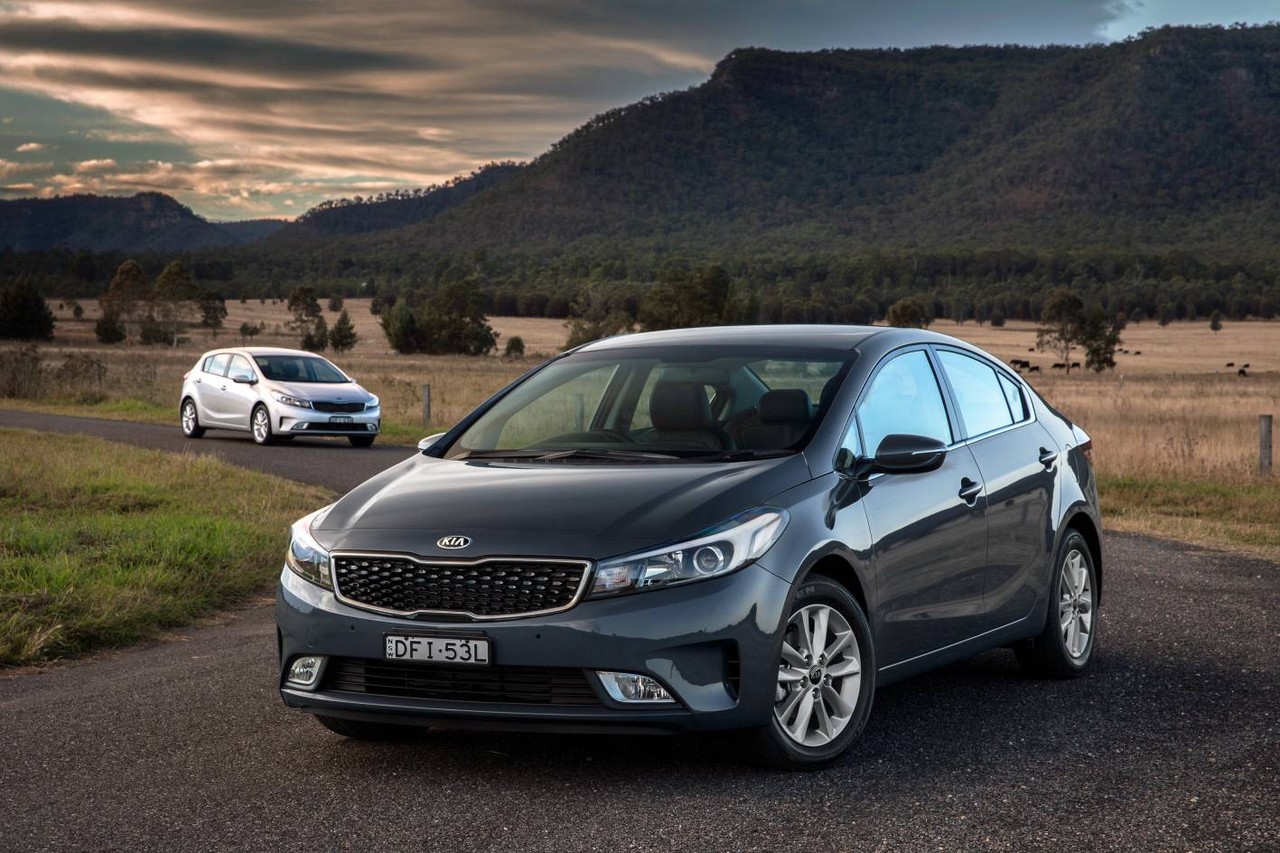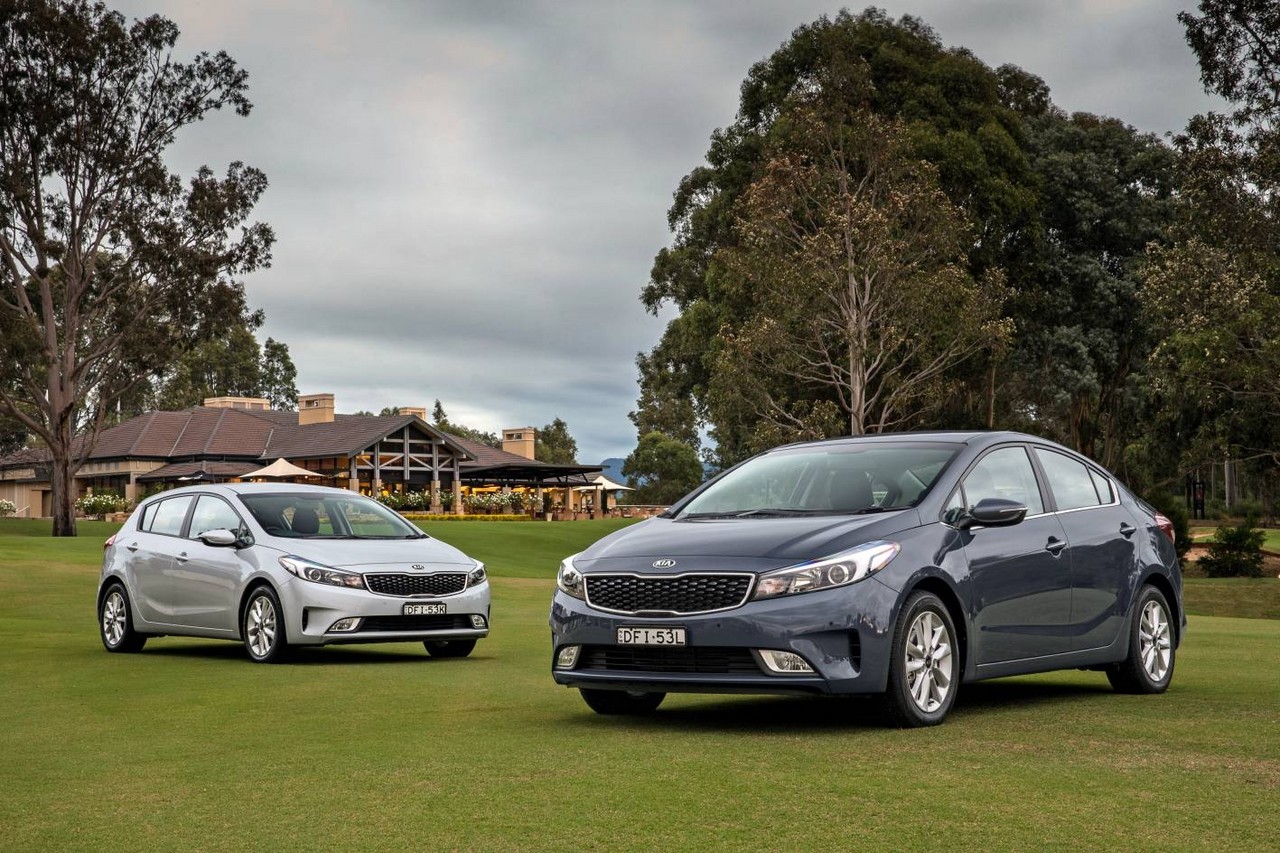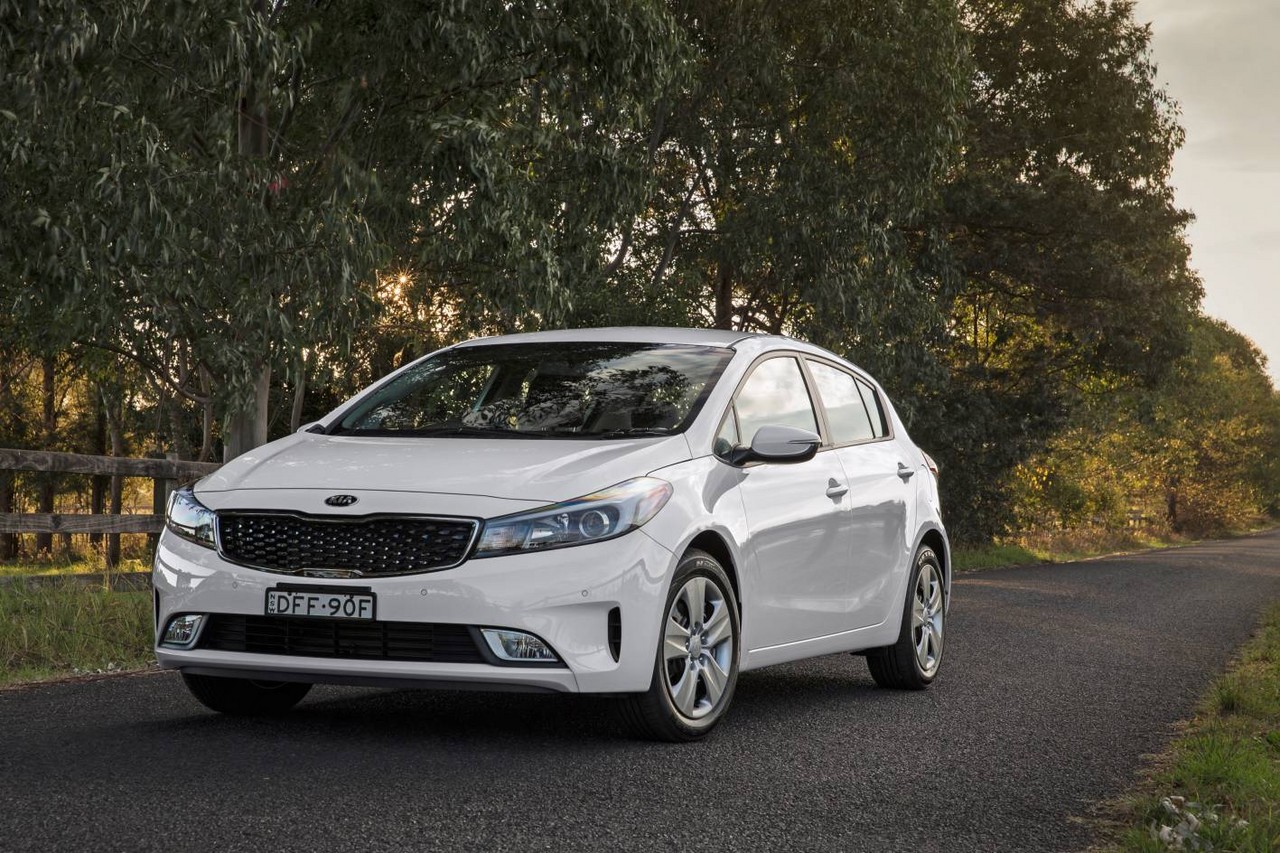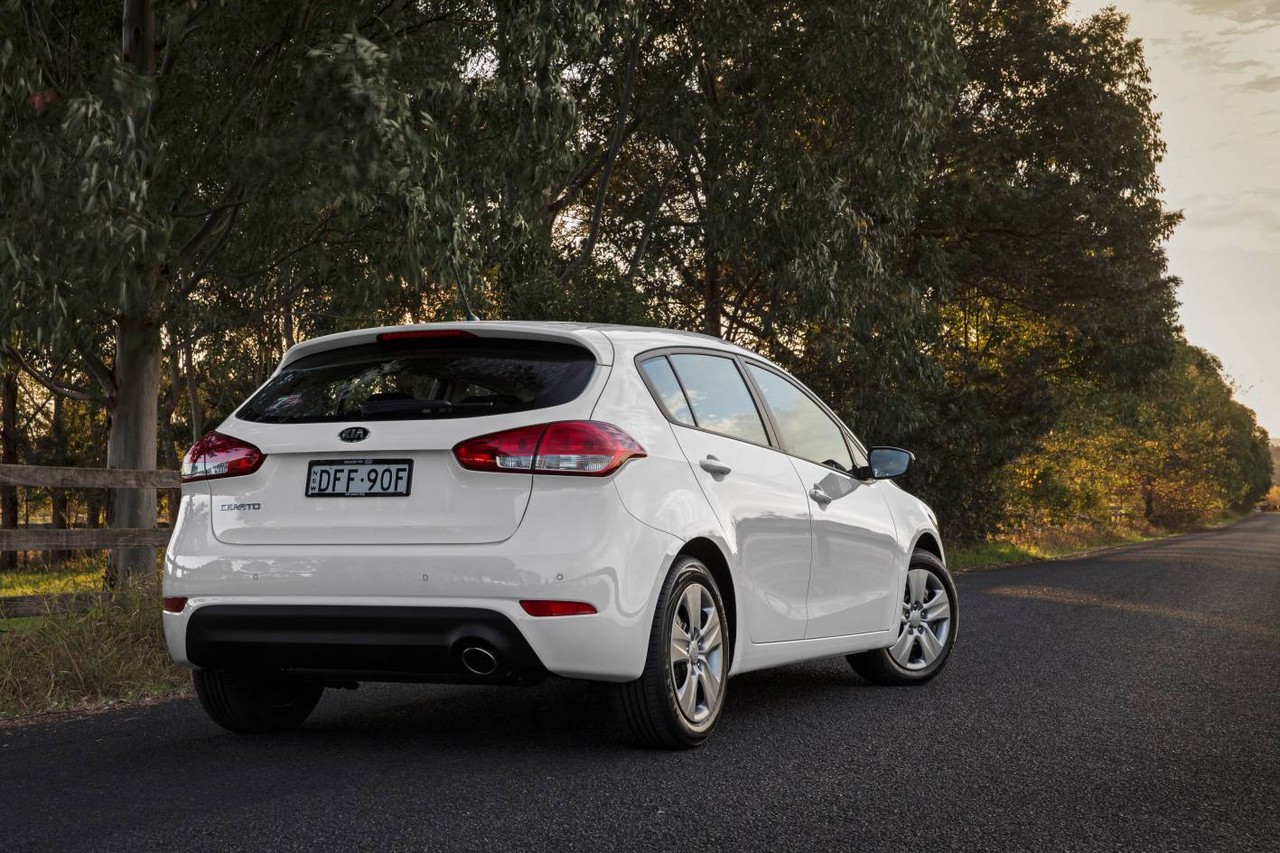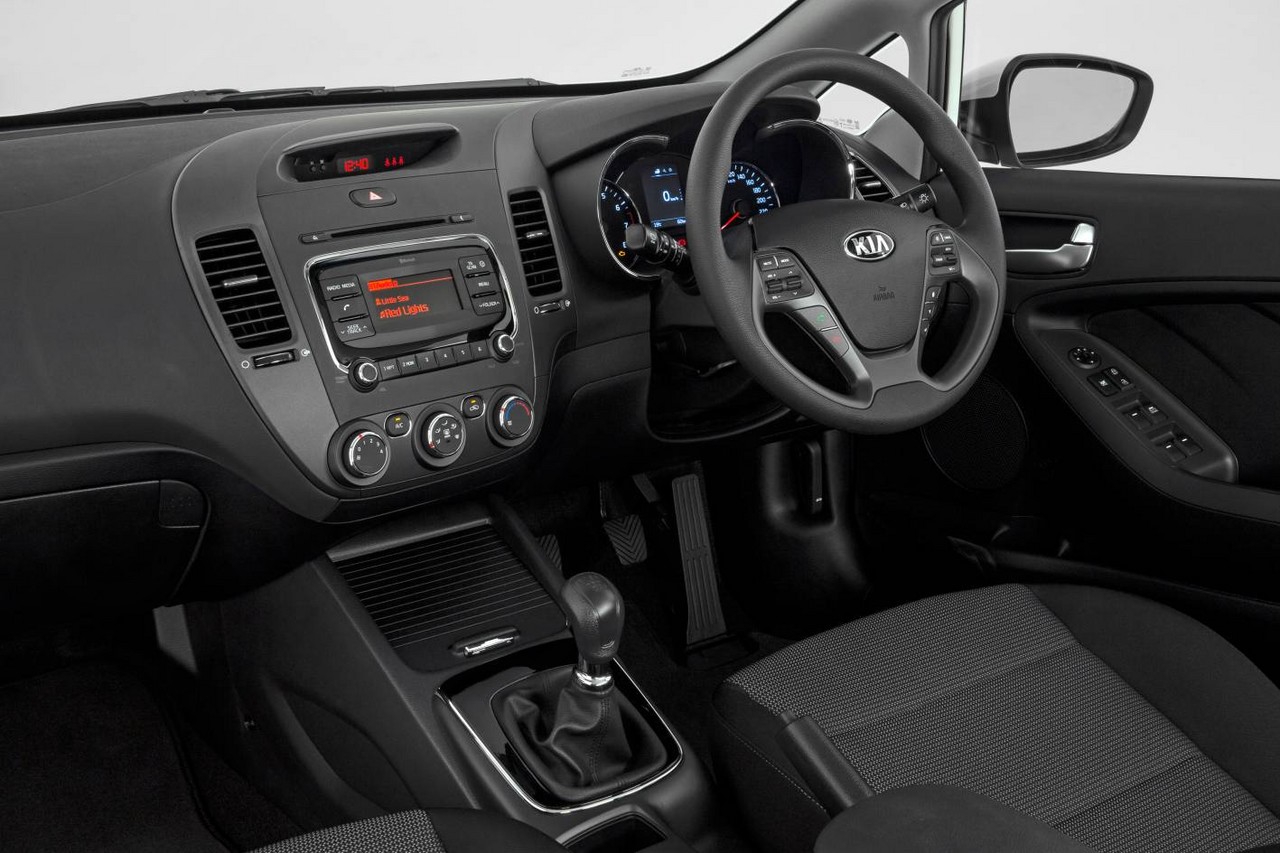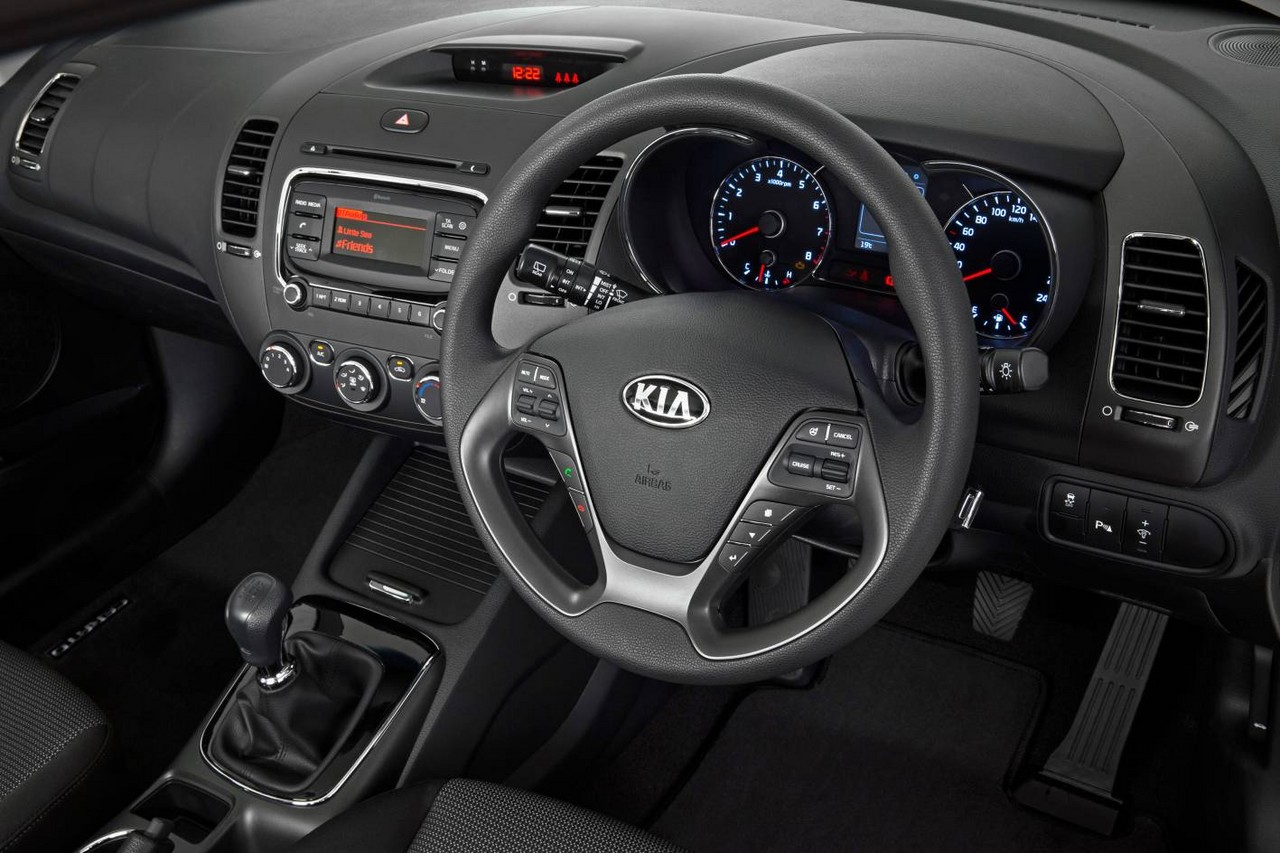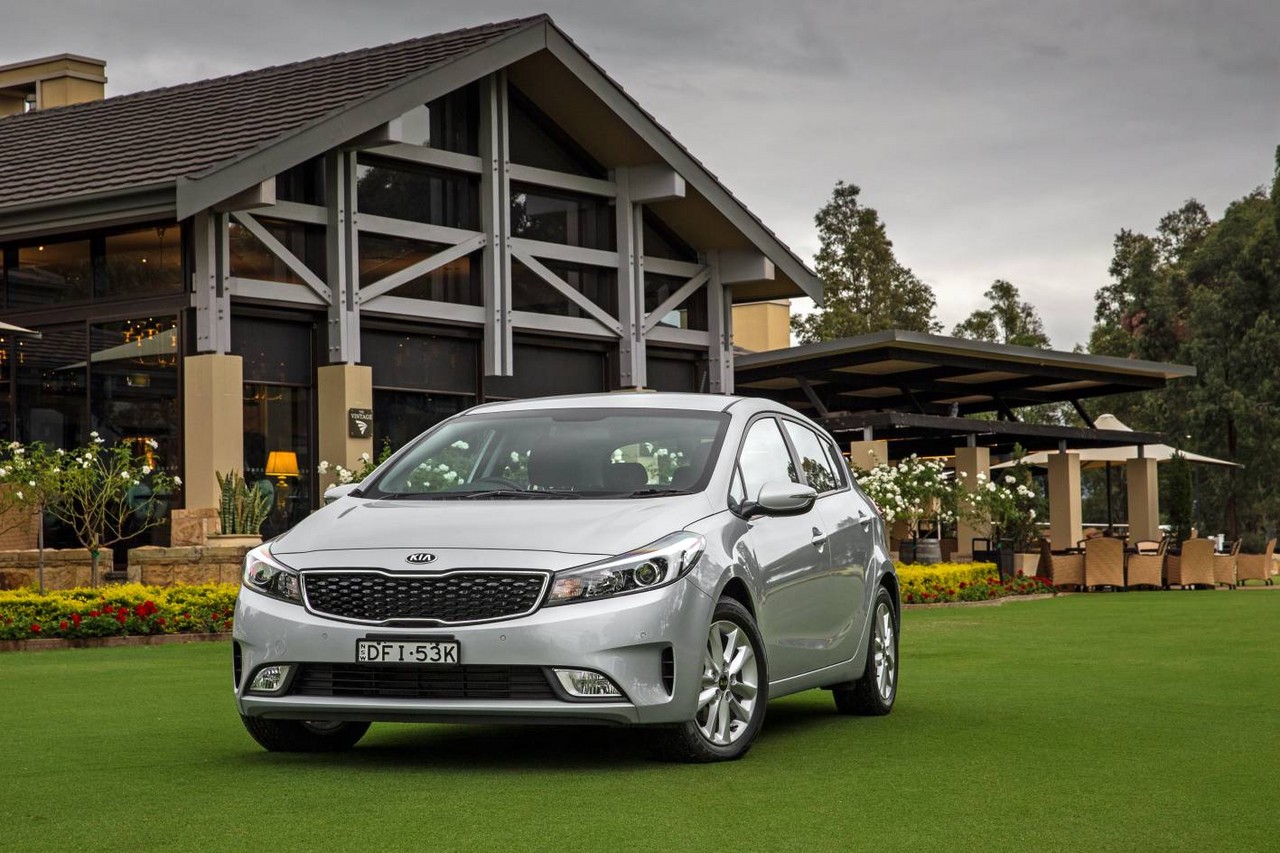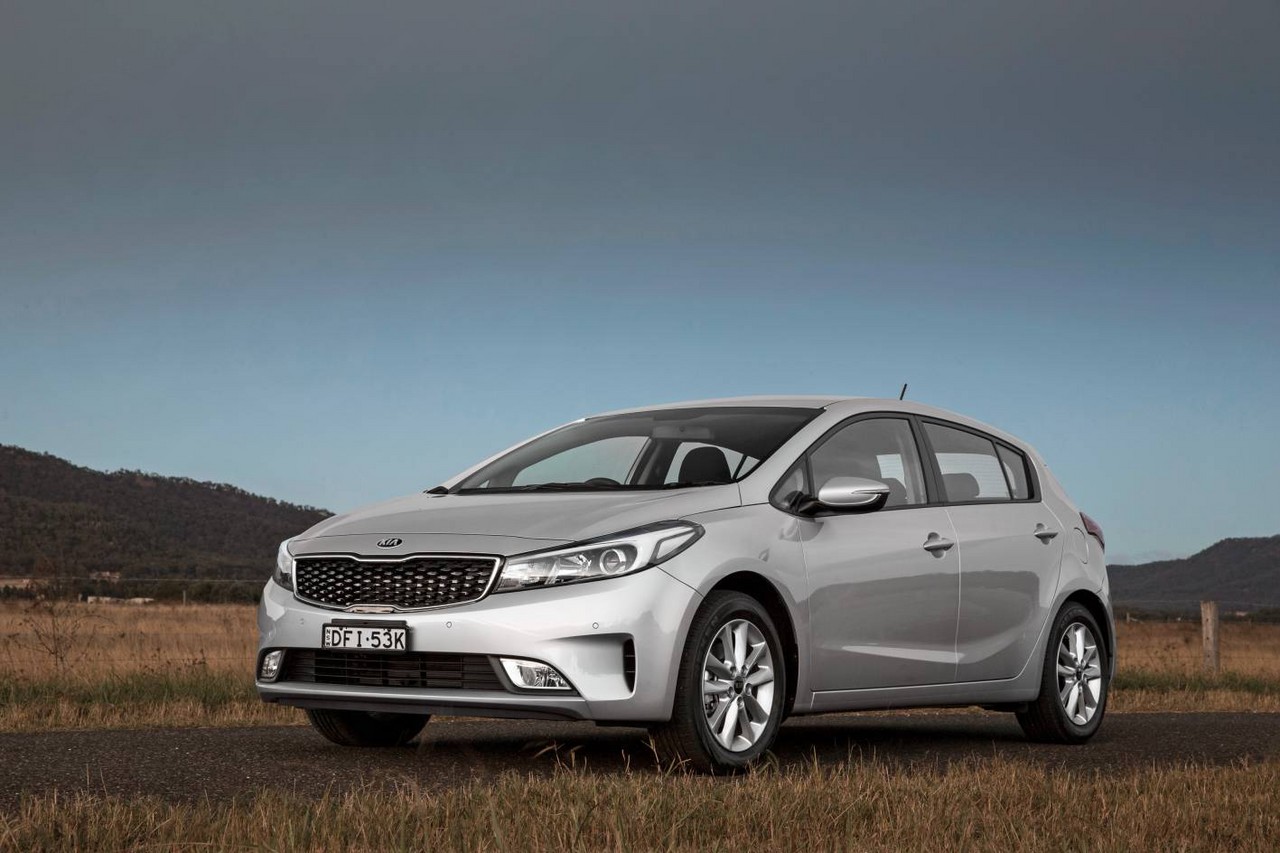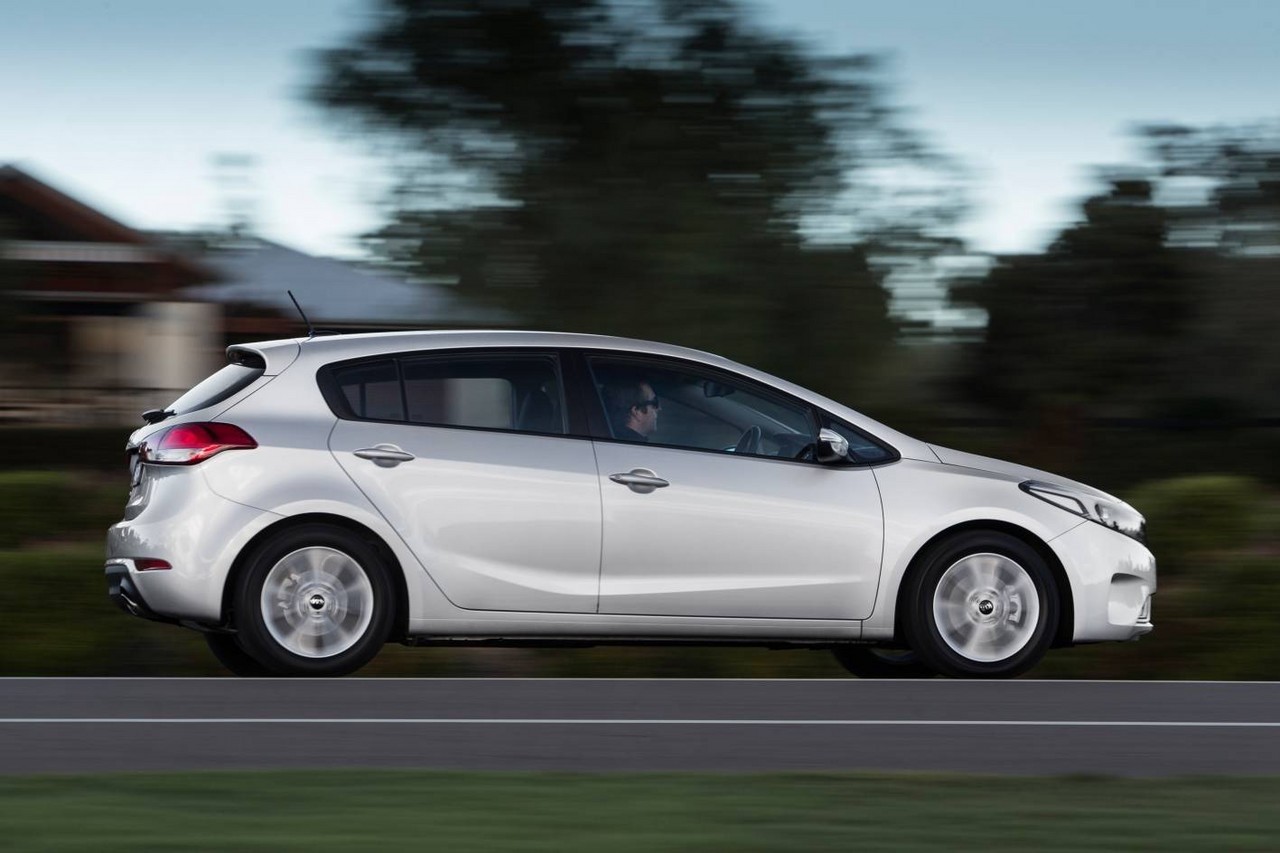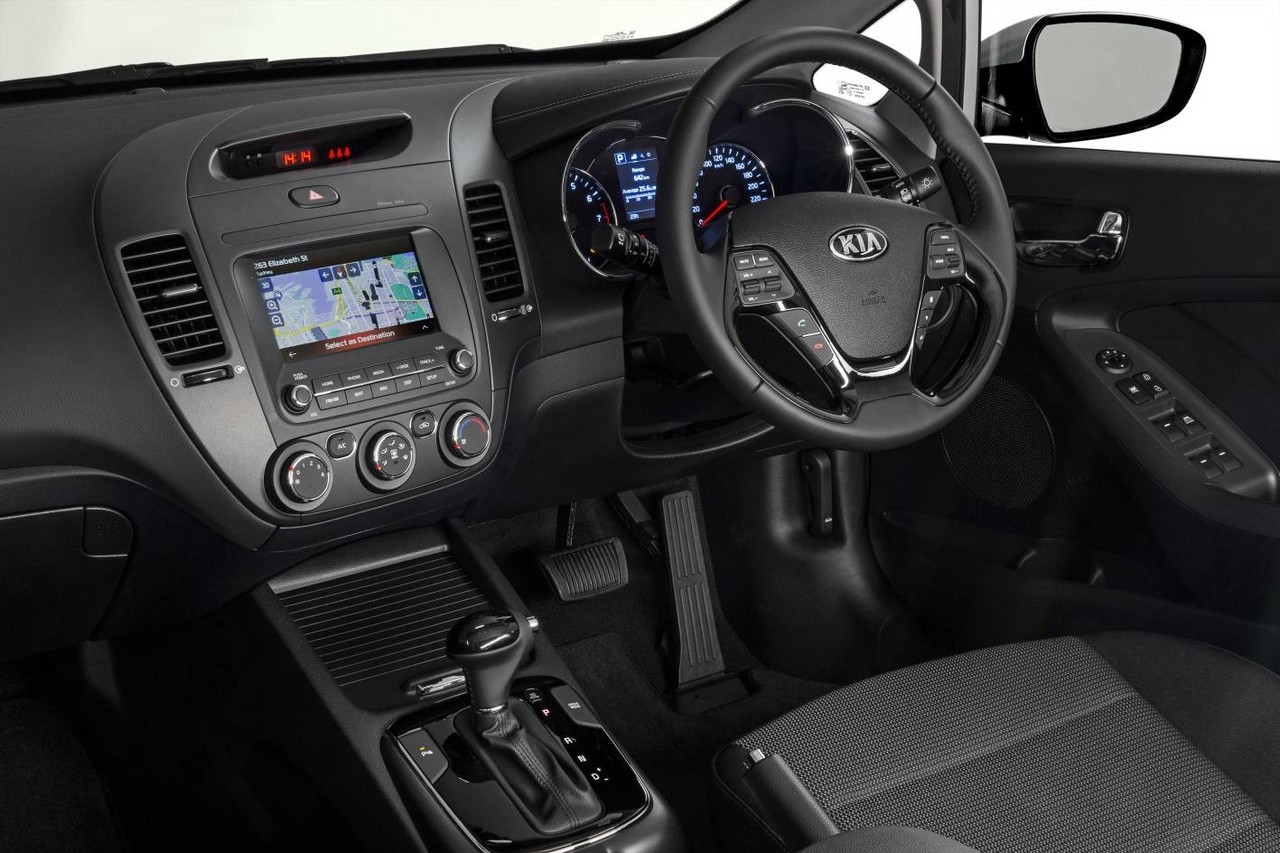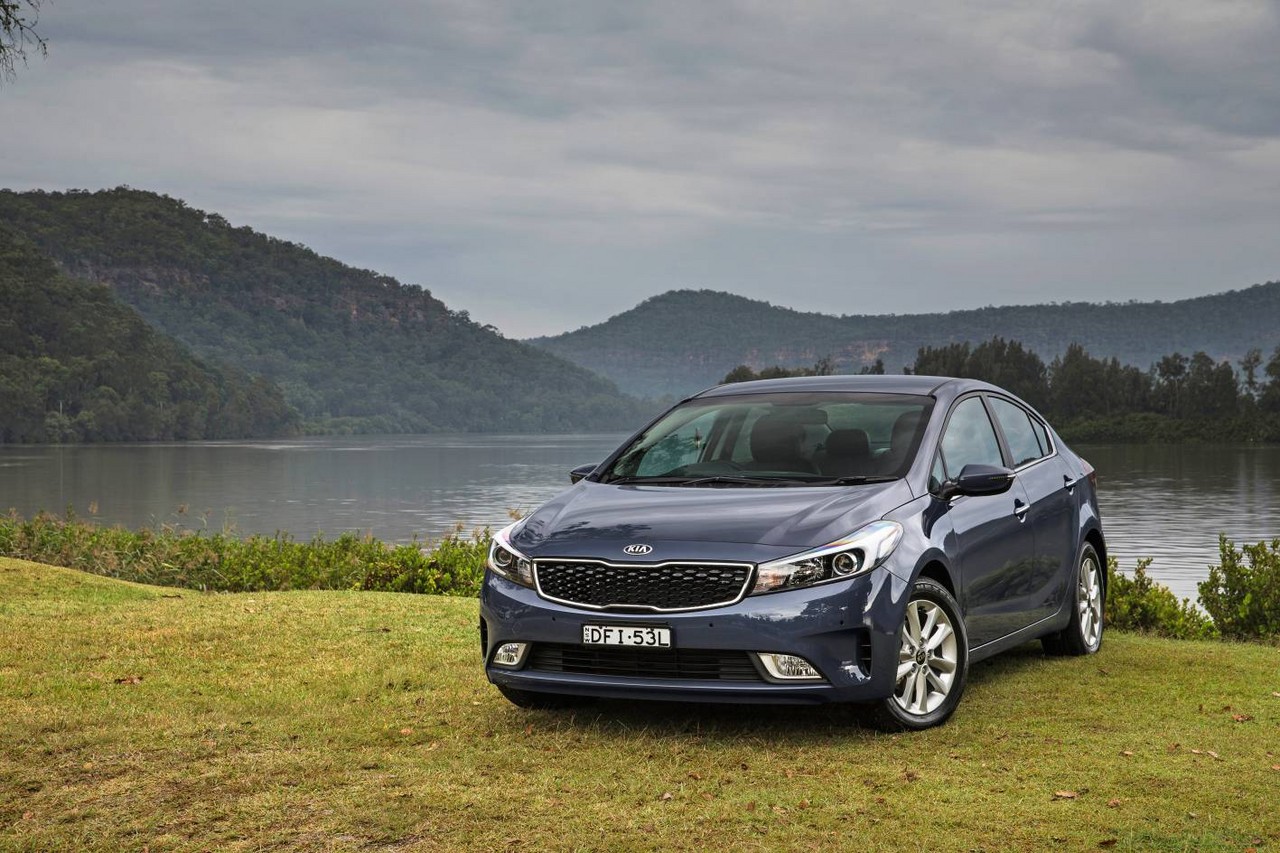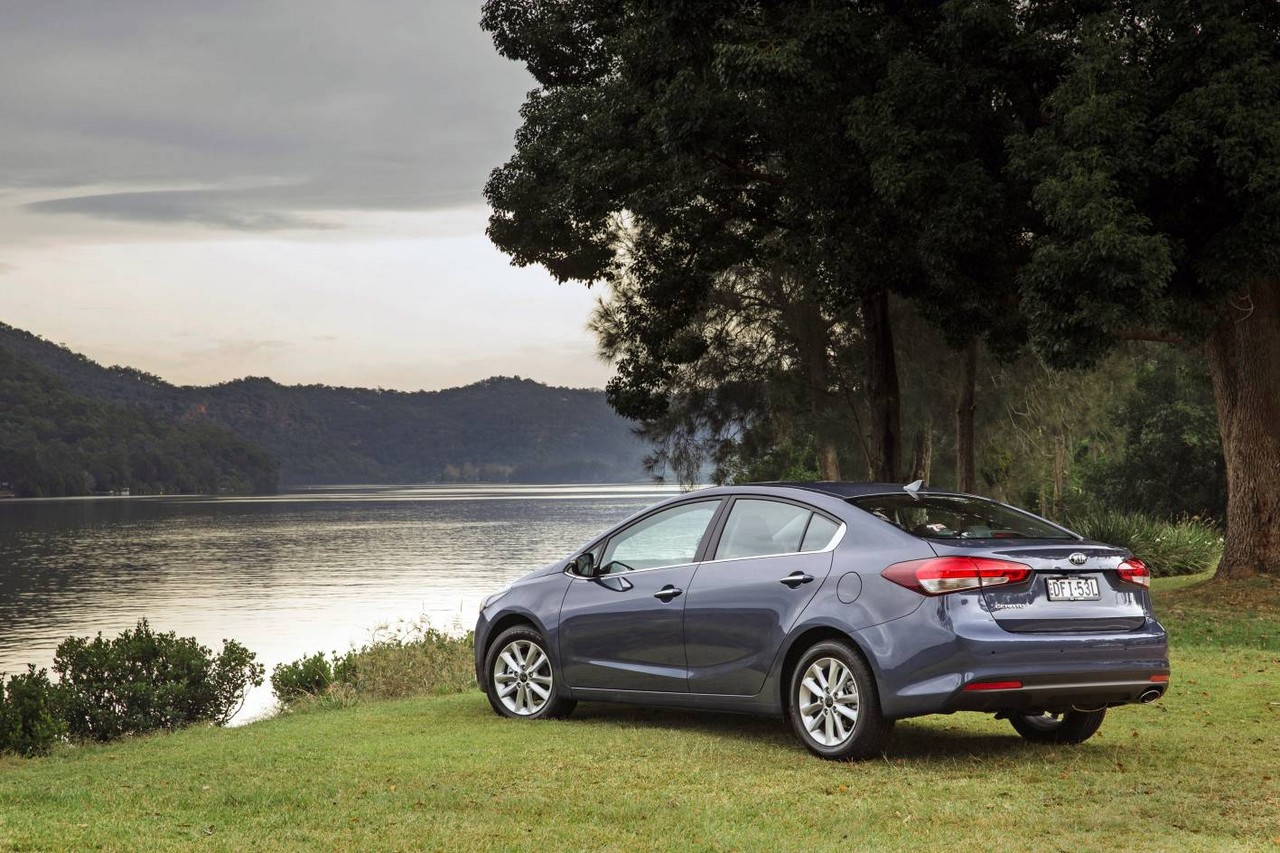
- Willing 1.8- and 2.0-litre petrol engines
- Australian-tuned suspension achieves good ride/handling balance
- Spacious interior
- Five-year warranty
- Steering lacks feedback and feel around centre
- Manual transmission has rubbery action
- Engine noise
- Cramped rear seat
- Not as engaging to drive as Ford Mk.3 Focus or Mazda BM Mazda3
Review: Kia YD.I Cerato (2013-16)
Overview
Released in April 2013, the Kia YD Series I (YD.I) Cerato was initially available as a sedan, with five-door hatchbacks following in August 2013 (the YD Cerato Koup has been reviewed separately). Manufactured in Hwasung, South Korea, the front-wheel drive Cerato was powered by 1.8- and 2.0-litre petrol engines that were mated to either six-speed manual or automatic transmissions. As per the table below, the YD Cerato range consisted S, Si and SLi variants.
G4NB and G4NC engines
Of the engines,
- the 1.8-litre G4NB ‘Nu’ petrol engine had an aluminium block and cylinder head, double overhead camshafts, four valves per cylinder, variable intake and exhaust valve timing (D-CVVT), a variable induction system, electronic throttle control and a compression ratio of 10.3:1; and,
- the 2.0-litre G4NC ‘Nu’ GDI petrol engine differed in that it had direct fuel injection and a compression ratio of 11.5:1.
| Engine | Variant | Years | Trans. | Peak power | Peak torque |
|---|---|---|---|---|---|
| 1.8-litre petrol I4 | S | 2013-16 | 6sp man., 6sp auto |
110 kW at 6500 rpm | 178 Nm at 4700 rpm |
| S Premium | 2014-16 | 6sp auto | 110 kW at 6500 rpm | 178 Nm at 4700 rpm | |
| 2.0-litre petrol I4 | Si, SLi |
2013-14 | 6sp man. | 129 kW at 6500 rpm | 209 Nm at 4700 rpm |
| 2013-16 | 6sp auto |
Development and dimensions
Compared to the Kia TD Cerato which preceded it, the YD Cerato bodyshell had a higher proportion of high-strength steel (63 per cent) which contributed to a 37 per cent increase in torsional rigidity. For greater refinement, the YD Cerato had new vibration-damping front subframe mountings, dual-frequency engine mounts and new insulation materials for the engine bay and cabin floor.
The YD Cerato hatch was 4350 mm long, 1780 mm wider, 1450 mm tall and had a 2700 mm long wheelbase. Relative to the hatch, the YD Cerato sedan, was 210 mm longer (at 4560 mm) and 15 mm lower (1435 mm), though width and wheelbase length were the same.
Suspension and steering
The Kia YD Cerato had MacPherson strut front suspension with wide L-shaped lower arms and a coupled torsion beam rear axle; both the front and rear suspension had coil springs and gas-filled shock absorbers. The YD Cerato, however, introduced a FlexSteer electric power steering system which enabled the driver to select from Normal, Sport and Comfort modes for varied levels of power assistance.
Safety equipment
Standard safety equipment for the Kia YD Cerato included dual front airbags, front side airbags, full-length curtain airbags (i.e. for front and rear occupants), ABS, brake assist, electronic brake force distribution, electronic stability control (ESC), traction control and front seatbelts with pretensioners and load limiters.
Furthermore, the Cerato had hill-start assist control (HAC) and a vehicle stability management (VSM) system which interacted with the ESC to provide ‘corrective’ steering inputs to prevent the driver from losing control.
Brakes
The Kia YD Cerato had 280 mm by 23 mm ventilated front disc brakes and 262 mm by 10 mm solid rear discs.
ANCAP crash testing
In ANCAP crash testing , the Kia YD Cerato sedan and hatchback models received a five star adult occupant protection rating with a score of 35.51 out of 37. In the offset crash test, occupant protection for the front occupants was generally good, though there was a slight risk of serious chest injury for the driver’s chest and lower leg and for the passenger’s lower legs. In the side impact and pole tests, however, maximum points were awarded.
Features: Cerato S, S Premium, Si and SLi
Standard features for the Cerato S included 16-inch steel wheels with 205/55 R16 tyres (and a full-size spare), a six speaker sound system with a CD player, MP3-compatibility and auxiliary inputs (3.5 mm/USB/iPod), air conditioning, a six-way adjustable driver’s seat, black cloth upholstery, cruise control, front and rear fog lights, front corner and rear parking sensors, Bluetooth mobile phone connectivity and audio streaming, 60/40 split and folding rear seats, remote central locking, power windows and heated mirrors, a height and reach adjustable steering wheel, two 12 volt power outlets, a trip computer and an immobiliser.
The Cerato S Premium was further equipped with 16-inch alloy wheels, a seven-inch touch screen with satellite navigation and a DVD player, and automatic headlights.
Initially, the Cerato Si and Cerato SLi were fitted with a 4.3-inch touch screen rather than a seven-inch unit with satellite navigation and a DVD player, though these features were made standard for the Si and SLi variants in June 2014 (coinciding with the release of the Cerato S Premium). Relative to the S Premium, the Cerato Si added knit and tricot upholstery, a reversing camera with parking guidelines, proximity key, push-button start and power folding mirrors. Visually, the Cerato Si and SLi variants could be identified by the chrome highlights on their belt-lines, door handles and exhaust outlets.
The range-topping Cerato SLi was distinguished by its 17-inch alloy wheels with 215/45 R17 tyres, dual-zone climate control air conditioning, leather seat trim, heated front seats, an eight-way power adjustable and ventilated driver’s seat, driver’s seat memory settings, xenon headlights, daytime LED running lights, LED tail lights, a powered glass sunroof, cooled glove box, 4.2-inch LCD colour instrument cluster and an electrochromic rear view mirror. Models with automatic transmissions were also fitted with steering wheel gearshift paddles.
Brochures
- Brochure: Kia YD Cerato Hatch (November 2013)
- Brochure: Kia YD Cerato (April 2013)
- Brochure: Kia YD Cerato (September 2014)
Specifications
Review: Kia YD.II Cerato (2016-18)
Overview
Released in May 2016, the Kia YD Series II (YD.II) Cerato introduced a new 2.0-litre petrol engine, updated styling and interiors, and additional safety equipment for the Cerato Si and SLi variants. In April 2017, the Cerato S Premium was replaced by the Cerato Sport.
The Kia YD.II Cerato could be identified by its revised front mask with black or gloss black trim for Kia’s ‘tiger-nose’ grille, new headlights, bumper, fog lights and re-profiled bonnet; the YD.II Cerato also had a new rear bumper and tail-light design. Inside, the Kia YD.II Cerato featured new materials for the dashboard, door trims, centre fascia and console head. Furthermore, the gearstick was redesigned for improved ‘comfort when actuating shifts’ and there was new metallic trim around the air vents.
G4NA engine
The YD.II Cerato was powered by Kia’s 2.0-litre G4NA petrol engine which was a member of Kia’s ‘Nu’ petrol engines (like the G4NB and G4NC engines it replaced). Unlike the G4NC engine, however, the G4NA engine had multi-point injection rather than direct injection and a compression ratio of 10.3:1.
| Engine | Variant | Trans. | Peak power | Peak torque |
|---|---|---|---|---|
| 2.0-litre G4NA petrol I4 | S | 6sp man., 6sp auto |
112 kW at 6200 rpm | 192 Nm at 4000 rpm |
| S Premium, Sport, Si, SLi |
6sp auto |
Suspension and steering
The suspension for the YD.II Cerato included stiffer front springs, while the use of square orifice pistons enabled greater damper compliance. The Cerato’s column-mounted Motor Driven Power Steering (C-MDPS) was revised with a new steering motor, 32 bit ECU (previously 16 bit) and increased stiffness in the column shaft, bushings and steering gear. For Cerato models with automatic transmissions, the driver could select from three steering modes – Normal, Eco and Sport – which varied the level of steering assistance.
Safety equipment
Compared to the Kia YD.I Cerato, standard safety equipment for the YD.II Cerato was unchanged, i.e. dual front airbags, front side airbags, full-length curtain airbags (i.e. for front and rear occupants), ABS, brake assist, electronic brake force distribution, electronic stability control (ESC), traction control and front seatbelts with pre-tensioners and load limiters.
Beyond this, however, the Cerato Si and SLi added:
- Blind Spot Detection (BSD) with Lane Change Assist (LCA): monitored the area up to 70 metres behind the Cerato and provided a visual warning in the door mirror when another car enters the driver’s blind spot; and,
- Rear Cross Traffic Alert (RCTA): could detect approaching traffic that may cross the vehicle’s intended path when reversing out of a parking space.
Furthermore, the Cerato SLi was also fitted with:
- Forward Collision Warning (FCWS): used a radar to monitor the distance to obstacle ahead of the vehicle. If a collision risk was detected, the driver would receive audible and visual alerts; and,
- Lane Departure Warning System (LDWS): if the vehicle was detected to have departed from its lane without the driver having previously indicated, an audible tone would sound to alert the driver.
Features: Cerato S
Standard features for the Kia YD.II Cerato S included 16-inch steel wheels with 205/55 R16 tyres, a six speaker sound system with CD player (MP3-compatible), auxiliary and USB inputs with iPod compatibility, Bluetooth mobile phone connectivity and audio streaming, cloth seat trim, a six-way adjustable driver’s seat (including height), air conditioning, cruise control, front and rear fog lights, front and rear parking sensors, 60:40 split fold rear seats, remote central locking, power adjustable and heated mirrors, power windows, a height and reach adjustable steering column, two 12 volt power outlets (front console), a trip computer, an alarm and immobiliser.
Features: Cerato S Premium
Compared to the Cerato S, the Cerato S Premium was further equipped with 16-inch alloy wheels, a seven-inch colour LCD touchscreen with satellite navigation, Android Auto compatibility, a rear view camera with parking guidelines, dusk-sensing headlights, a ‘premium’ steering wheel and gearshift knob, a leather-wrapped instrument cluster and soft-touch upper door trim material.
Features: Cerato Sport
Released in April 2017, the Kia Cerato Sport effectively replaced the S Premium variant. Compared to the Cerato S Premium, the Cerato Sport had 17-inch alloy wheels with 215/45 R17 tyres and Apple CarPlay smartphone integration; the latter was also introduced for the Cerato Si and Cerato SLi.
Features: Cerato Si
Relative to the S Premium, the Cerato Si featured leather seat trim, power folding door mirrors with puddle lights, push-button start, door handle pocket lights, illuminated vanity mirrors, a UV-reducing windscreen and ‘carbon-fibre look’ interior trim inserts.
Visual cues for the Cerato Si and SLi included chrome trim for the waist-line and door handle, and a chrome exhaust tip.
Features: Cerato SLi
The range-topping Cerato SLi was distinguished by its 17-inch alloy wheels with 215/45 R17 tyres, a ventilated and eight-way power adjustable driver’s seat, heated front seats, dual-zone climate control air conditioning with ‘Clean Air’ module and rear air vents, xenon headlights, LED daytime running lights, LED rear combination lights, steering wheel gearshift paddles, an electrochromic rear view mirror, a cooled glovebox, power-operated sunroof, alloy sports pedals and colour TFT ‘Supervision’ instrument cluster.
Specifications
Related links
- Kia Motors Australia: Kia Cerato Sedan
- Kia Motors Australia: Kia Cerato Hatch
- Behind the Wheel: 2017 Kia Cerato S Review
- Behind the Wheel: 2017 Kia Cerato Sport Review
- Wikipedia.org: Kia Forte (second generation)
